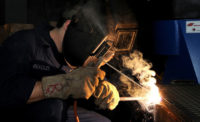 Q. What is a fume plume?
Q. What is a fume plume?
A. The fume plume is the clearly visible column of fume that rises directly from the spot of welding or cutting. Welders and cutters should take precautions to avoid breathing this area directly. Ventilation can direct the plume away from the face. (Fume removal is most effective when the air flow is directed across the face of the welder, rather than from behind.)
Q. How do I know what hazardous materials I may be using?
A. Check the Safety Data Sheet. The suppliers of welding materials must provide an SDS or equivalent documentation identifying the hazardous materials, if any, used in welding and cutting products.
Q. Where should oxygen not be used and why?
A. Oxygen should not be used as a substitute for compressed air. It should not be used in pneumatic tools, in oil preheating burners, to start internal combustion engines, to blow out pipelines, to dust clothing or work or to create pressure for ventilation or similar applications. Oxygen should not be used as described due to the possibility of a raging oxygen-fed fire occurring. Oxygen is not flammable, but vigorously supports combustion. Oxygen can be absorbed by clothing. A slight spark can result in severe burns.
Q. What is Mapp gas?
A. Mapp gas is a product that was developed as a fuel for welding, brazing, cutting, flame hardening and metallizing operations. It has many of the physical properties of acetylene, but lacks its shock sensitivity, and therefore, can be stored and shipped in lighter containers. Mapp gas is the result of rearranging the molecular structure of acetylene and propane. It also has a very distinct odor so any leakage can readily be detected.
Sources
ANSI Z49.1:2012, American National Standards Institute: Safety in Welding and Cutting.
29 CFR 1910.251-257, Welding.
Safety in Welding and Cutting, American Welding Society, 1988.
Workplace Safety in Action: Safe Welding Operations, J.J. Keller & Associates, Inc., August, 1995.
(Rev. 11/2012)
Source: W.W. Grainger
Welding safety: frequently asked questions



